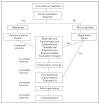Recent progress in understanding pediatric pulmonary hypertension
- PMID: 21572384
- PMCID: PMC3128451
- DOI: 10.1097/MOP.0b013e3283464a52
Recent progress in understanding pediatric pulmonary hypertension
Abstract
Purpose of review: Pulmonary artery hypertension (PAH) in children contributes significantly to morbidity and mortality in diverse pediatric cardiac, lung, hematologic and other diseases. Advances in pulmonary vascular biology over the past few decades have significantly expanded therapeutic strategies; however, many unique issues persist regarding our understanding of pediatric PAH.
Recent findings: Recent studies of pediatric PAH include those that highlight gaps in our understanding of pediatric diseases associated with PAH from those of adult onset, emphasizing the strong need for specific studies regarding unique aspects of the pathogenesis and treatment of children with PAH. Registries have begun to provide new data showing differences in physiology, course, and genetics between adult and pediatric forms of PAH. Unfortunately, therapeutic strategies in pediatric pulmonary hypertension are often limited to small observational studies in children and are dependent on results from larger adult studies. In addition, clinical endpoints for studies and care remain poorly defined in infants and children.
Summary: Despite many advances, long-term outcomes for children with PAH remain guarded and substantial challenges persist, especially with regard to understanding mechanisms and approach to severe PAH. Future studies are needed to develop novel biomarkers, clinical endpoints and interventions for young children with diverse causes of PAH.
Figures
Similar articles
-
Advances in pediatric pulmonary arterial hypertension.Curr Opin Cardiol. 2012 Mar;27(2):70-81. doi: 10.1097/HCO.0b013e32835018cd. Curr Opin Cardiol. 2012. PMID: 22274573 Free PMC article. Review.
-
Pediatric pulmonary arterial hypertension.Curr Hypertens Rep. 2013 Dec;15(6):606-13. doi: 10.1007/s11906-013-0399-3. Curr Hypertens Rep. 2013. PMID: 24163011 Review.
-
Advances in targeted therapy for pulmonary arterial hypertension in children.Eur J Pediatr. 2023 May;182(5):2067-2076. doi: 10.1007/s00431-022-04750-y. Epub 2022 Dec 17. Eur J Pediatr. 2023. PMID: 36527480 Review.
-
Pulmonary arterial hypertension : a comprehensive review of pharmacological treatment.Treat Respir Med. 2006;5(2):117-27. doi: 10.2165/00151829-200605020-00005. Treat Respir Med. 2006. PMID: 16512692 Review.
-
Phosphodiesterase 5 inhibitors for pulmonary hypertension.Cochrane Database Syst Rev. 2019 Jan 31;1(1):CD012621. doi: 10.1002/14651858.CD012621.pub2. Cochrane Database Syst Rev. 2019. PMID: 30701543 Free PMC article.
Cited by
-
Diagnosis and treatment of pulmonary hypertension in infancy.Early Hum Dev. 2013 Nov;89(11):865-74. doi: 10.1016/j.earlhumdev.2013.09.012. Epub 2013 Sep 29. Early Hum Dev. 2013. PMID: 24083892 Free PMC article.
-
Frontiers in pulmonary hypertension in infants and children with bronchopulmonary dysplasia.Pediatr Pulmonol. 2012 Nov;47(11):1042-53. doi: 10.1002/ppul.22609. Epub 2012 Jul 6. Pediatr Pulmonol. 2012. PMID: 22777709 Free PMC article. Review.
-
Pharmacotherapy for pulmonary hypertension.Pediatr Clin North Am. 2012 Oct;59(5):1129-46. doi: 10.1016/j.pcl.2012.07.011. Epub 2012 Aug 26. Pediatr Clin North Am. 2012. PMID: 23036248 Free PMC article. Review.
-
Serum Pentraxin 3 and hs-CRP Levels in Children with Severe Pulmonary Hypertension.Balkan Med J. 2014 Sep;31(3):219-23. doi: 10.5152/balkanmedj.2014.13307. Epub 2014 Sep 1. Balkan Med J. 2014. PMID: 25625020 Free PMC article.
-
Obstructive sleep apnea in children: a critical update.Nat Sci Sleep. 2013 Sep 25;5:109-23. doi: 10.2147/NSS.S51907. Nat Sci Sleep. 2013. PMID: 24109201 Free PMC article. Review.
References
-
- D’Alonzo GE, Barst RE, Ayres SM, et al. Survival in patients with primary pulmonary hypertension: results from a national prospective registry. Ann Intern Med. 1991;115:343–349. - PubMed
-
- McLaughlin VV, Shillington A, Rich S. Survival in primary pulmonary hypertension: the impact of epoprostenol therapy. Circulation. 2002;106:1477–1482. - PubMed
-
- Simonneau G, Galie N, Rubin LJ, et al. Clinical classification of pulmonary hypertension. J Am Coll Cardiol. 2004;43 (Suppl):S5–S12. - PubMed
-
- Humbert M, Mclaughlin VV. The 4th World Symposium on Pulmonary Hypertension. J Am Coll Cardiol. 2009;54:S1–S2. - PubMed
Publication types
MeSH terms
Substances
Grants and funding
LinkOut - more resources
Full Text Sources
Medical
Research Materials
Miscellaneous


